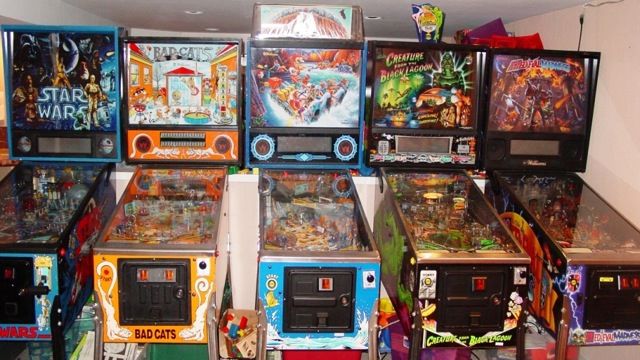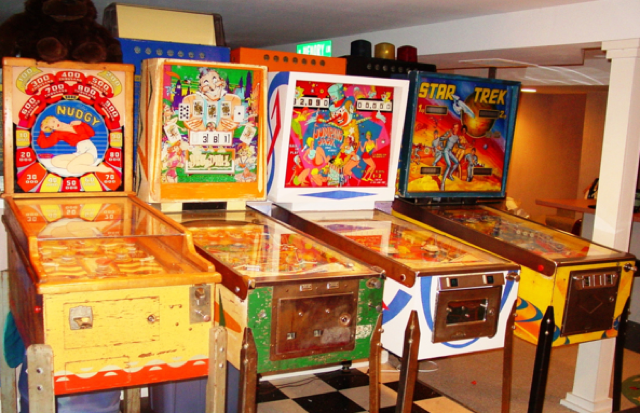-
Inside this concrete slab hides the biggest collection of the rarest pinball and electromechanical games ever made.Sam Machkovech
-
This was taken by standing on a chair in one corner of the venue. You can get a sense of the machine variety here: mostly pinball and electromechanical, with about one-fifth of the space dedicated to video games.Sam Machkovech
-
This is probably the best representation of the dim lighting in the room.Sam Machkovech
-
Follow the rules.Sam Machkovech
-
The rarest machine in the house by far, Midway’s Pinball Circus. Only two were ever made.Sam Machkovech
-
We chose not to reproduce most of the information cards so you would have more to read should you visit the venue. But we had to post a few. This one’s crucial.
-
The VPHoF’s oldest pinball machine is from the 1920s. “These things used to be outlawed!” our guide reminded us.
-
That old machine sits next to arguably the collection’s highest-tech virtual pinball machine.
-
An average dive into an older machine. Start with the full, beautifully restored machine.
-
Then look closer at the Atlantis pin’s general body and layout.
-
Then zoom in on its information card. You’ll possibly need to squint.
-
Nearly one third of the room is dedicated to this ’50s and ’60s era of pins.
-
A few Elton John-based machines were in the house.
-
We did the best we could with the room’s weird lighting, in terms of imbalances thanks to inlaid lights in the machines.
-
Abra-ca-dabra! It sure was a different era when Gottlieb made so many pins.
-
Imagine if this game’s designers pulled off a mechanical way to arrange dominoes like shown in the art. Even so, it’s a striking design as drawn.
-
-
-
I’m still floored by how the bouncy balls inside that Hi-Score Pool pin worked in action.
-
-
A closer look.
-
-
The collection’s more modern machines flank the wall near the entrance.
-
It’s impossible to get a photo that makes Black Hole look as good as it does in real life. Its black-on-black-on-black style has an incredible glow and effect.
-
More of Gottlieb’s best era.
-
A collection so bustling, Creature Of The Black Lagoon gets crowded out.
-
-
Not to be confused with Peppy the Clown, who appears in the second gallery.
-
KISS returned with a modern pin via Stern; this is not that version.
-
-
-
Street Fighter II: The Video Game: The Pinball Game.
-
-
This probably cost less to produce than the related film.
-
No shortage of sci-fi-themed pins at the VPHOF.
-
Not every day you run into the phrase Goldeneye 007 flanked by a big Sega logo. This came before Nintendo and Rare’s N64 classic.
-
I can think of two Elvira-themed pinball games from the 1980s, including this one.
-
-
One row had a space theme.
-
Another angle of those two pins, with ST:TNG flanking.
-
Continuing the space-license theme.
-
-
-
-
A zoom on that Spider-man machine.
-
This rare Q-bert machine is a treat.
-
Great ramps and action.
-
Not many of these exist.
-
And even fewer of its Goin’ Nuts spinoff exist. Like, only 10.
-
-
-
It’s hard to tell from the photo, but this Flintstones cab is gargantuan. About as big as a typical arcade-hall basketball game.
-
Giant flippers.
-
More Flintstones info.
-
-
Vegas, baby.
-
In case the full pinball table didn’t make it clear, this is a pinball game. Hold that pinball, Freddy.
-
Nightmare’s game board.
-
For a short spell, a few games capitalized on the popularity of Caddyshack by including old white dudes, golf, and pesky gophers. None of them officially mentioned Caddyshack.
Pinball is dying, if it’s still alive at all. The major manufacturers have moved from creating pinball machines to slot machines for casinos, a business with a much rosier future. With even larger arcades only sporting one or two pinball machines, most likely emblazoned with licensed artwork from a popular movie or TV show, enthusiasts of the game are forced to look backward for their joy, not forward.
“Pinball has seen a steady decline since the 90s. Chicago used to have many manufacturers that cranked out thousands of games each year. In the 80s and 90s, video games became popular and pinball sales suffered,” Karl Marsicek explained to Ars. He knows a little bit about the lost art of pinball: his basement houses a collection of machines he has bought and restored. “There is only one manufacturer left, Stern Pinball. They put out about 4 or 5 new titles each year, just a fraction of what manufacturers were cranking out in Pinball’s glory days.”
As a hobby, collecting and restoring pinball machines is tough. The machines are loud, large, heavy, and expensive. The problem is, if you can’t play a game at your local arcade, the only place left is your own basement. “The many machines that were produced in the ’80s and ’90s have reached the end of their life cycle and are disappearing from bars and pizza joints,” Marsicek said. “Strip mall arcades are just about extinct because of computer games and gaming consoles. So pinball machines are getting hard to find.”
The beginning of the obsession
Everyone remembers their first love, and for Karl, his was named Bad Cats. He first saw the machine at a resort in Indiana, on the way to a club on an early date with his wife. They never made it to the club, although he did pump a significant amount of money into the machine over the next few hours.
“I remember really liking the cheesy art and sounds on the game and thinking, ‘I gotta have one of these!’ I wrote the name of the game and the manufacturer on the back of a business card and stuck it in my wallet, and decided that after we bought a house I’d look into buying one.” It wasn’t an idle threat. Five years later he had his home, and he started looking for that machine. It turned out that Bad Cats was a machine with a low production number, so it wasn’t as simple as sending someone a check. Proving his dedication, he looked for a year, until two units showed up on eBay. He bought the better-looking machine and had it shipped to his house.

The problem? The game didn’t work properly when it arrived, and no one in the area knew how to fix it. “But it turned out to be a blessing in disguise because it forced me to open up the game and find resources on the Web. I was eventually able to fix everything that was broken on it and it still sits in my basement,” Marcizek said. Soon he knew other pinball enthusiasts and began attending shows. He bought jukeboxes, slot machines, and restored other coin-operated amusements. “But my real passion is with pinball machines,” he stressed.
Remember folks, these machines had actual moving parts
Time is not kind to pinball machines. “Electromechanical games—games with score reels instead of digital displays—have hundreds of switch contacts that are engaged when the game is turned on or a ball hits a playfield switch,” Marsicek told Ars. “If the machine sits for a long time, corrosion can build up on the switches and when you turn the game on the corrosion can prevent circuits from completing… The switches can be cleaned and adjusted.” It’s easy to do, but of course this requires a little bit of a time commitment.
“Solid-state games with digital displays typically have 3 AA batteries installed on the boards. The batteries back up custom settings when the game is unplugged, such as pricing info, high scores, etc.” It may seem easy to just swap out the batteries, but if the machines haven’t been taken care of, there can be more issues. “The problem is that the batteries often don’t get changed and start to corrode, then damage the circuit board. Some other components on solid-state games, like capacitors on circuit boards, reach the end of their life expectancy and need to be replaced.”

So what does Marsicek do when he buys a new machine? “Every game is different; some are well maintained by the previous owner and some don’t even power on. Before I try to turn it on, I check to make sure that all the correct fuses are installed and look over the machine for obvious problems like battery corrosion and wires that are broken or have missing/burnt insulation.” The next step is checking any included diagnostic menus for errors, and on older machines he checks each switch and coil to make sure everything is still in working order. Broken parts are fixed or replaced.
“After that I clean and wax the playfield, replace any missing or worn playfield rubber, replace burnt out light bulbs and install a new ball. Then I call my kids in and we play test it!” It’s not an easy or short process, but the rewards are great. “It sounds like a lot of work, but it’s not usually that bad… The games are designed for commercial use, so if you spend a little time looking things over they will last a long time in a home use environment.”
There are also great resources online. “Clay Harrell has written an online pinball repair guide that outlines maintenance tips for different generations of pinball machines, including steps to take before turning a game on for the first time. I always check his site for additional steps, especially if I am unfamiliar with the game generation or manufacturer. The guides are at http://marvin3m.com/fix.htm.”
http://arstechnica.com/gadgets/2009/07/fixing-the-past-the-art-of-collecting-pinball-machines/

